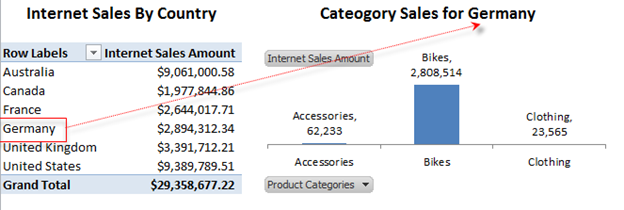In Part I, we looked at adding a data table to a Workbook which uses an external data source (we used OLAP but the process can be applied to any source). This post looks at manipulating an existing table.
Without VBA, we can manually manage the table – both the its properties and the underlying query. Simply right click on the table and select the Edit Query.. or External Data Properties from the popup menu. Changes are made to the table data are made automatically.

If we chose to edit the query, we can simply overwrite the Command Text (as seen in the image below). These changes well be automatically applied (including resizing the table by rows or columns for a different sized data set) once the OK button is clicked.

For External Data Properties, we can configure how the table reacts with new data. For example, you may notice that, the table accommodates additional rows and columns however, when the query returns a table with fewer rows and columns, the table retains its old sizing (number of columns) and includes a blank columns (for data that previously existed). You can manually resize this (dragging the bounds of the tables border) or set the properties of the table to overwrite existing data. If you want to ensure that this option exists and that new sizes are automatically incorporated into the table – make sure that the check box for Overwrite is marked in External Data Properties.

VBA
Now to the VBA – As commandant Lassard would say “There are many, many, many, many fine reasons to use VBA”. We have so much flexibility but let’s keep it simple, here’s what we I’ve set up.

Cell B1 is data validated based on the cell range D1:D2 – nice and simple. When we change that cell, the table updates for the new country.
In order to determine if the there is a change in or data (the Country selected) we have to create a worksheet event to capture and test the change. I have gone into this in some detail here and the code is below. Note that this needs to be added to the sheet code (not in a separate bas module). All we do is check that our only B1 is updated and then call the refresh subroutine.
Private Sub Worksheet_Change(ByVal Target As Range)
‘ update table if cell 1,B is changed
If Target.Cells.Count = 1 And Target.Cells.Row = 1 And Target.Cells.Column = 2 Then UpdateMyTable
End Sub
Now for the updating component – the bit that’s called when cell(B1) is changed. I think this is pretty straight forward but I’ll walk through it anyway. First, the code;
Public Sub UpdateMyTable()
‘ ensure that any new changes are reflected in the table dimensions
Sheet1.ListObjects(“Table_abax_sql3”).QueryTable.RefreshStyle = xlOverwriteCells
‘ set the comand text
Sheet1.ListObjects(“Table_abax_sql3”).QueryTable.CommandText = NewQuery(Sheet1.Cells(1, 2))
Sheet1.ListObjects(“Table_abax_sql3”).Refresh
End Sub
Private Function NewQuery(Country As String) As String
NewQuery = “select {[Measures].[Reseller Sales Amount] } on 0, ” & _
“[Product].[Category].[Category] on 1 ” & _
“from [Adventure Works] ” & _
“where [Geography].[Geography].[Country].&[” & Country & “]”
End Function
I’ve kept the same format as in the original post. The function NewQuery determines what the MDX should be – based on the provided country. All we is set the tables command to the new mdx (in (QueryTable.CommandText)) and refresh it.
I’ve also set the refresh style so that any changes in the command (grid size) are automatically reflected in the worksheet table.
That’s about the size of it! – I hope you find it useful.






